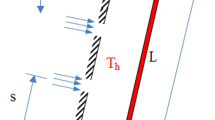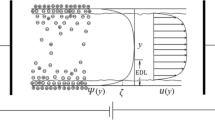Abstract
A numerical study has been carried out to investigate the effect on mixing of the position of fluid stream interfaces in a rectangular microchannel. The velocity profile in a microchannel has a parabolic shape which shows maximum local velocity at the center of the channel and minimum velocity near the wall. This velocity profile governs the residence time of the fluid streams and hence effects on the mixing of fluid streams. Single and double interfaces of the fluid streams have been studied in rectangular microchannels for the range of Reynolds numbers (0.1 ≤ Re ≤ 10) where mixing is mainly governed by molecular diffusion. Significant variations in the mixing performance have been shown at various positions of the interfaces at different Reynolds number.





Similar content being viewed by others
References
Abonnenc M, Josserand J, Girault HH (2009) Sandwich mixer–reactor: influence of the diffusion coefficient and flow rate ratios. Lab Chip 9:440–448
Adeosun JT, Lawal A (2009) Numerical and experimental studies of mixing characteristics in a T-junction microchannel using residence-time distribution. Chem Eng Sci 64:2422–2432
Bothe D, Sternich C, Warnecke HJ (2006) Fluid mixing in a T-shaped micro-mixer. Chem Eng Sci 61:2950–2958
Bothe D, Stemich C, Warnecke HJ (2008) Computation of scales and quality of mixing in a T-shaped microreactor. Comput Chem Eng 32:108–114
Burns MA, Johnson BN, Brahmasandra SN, Handique K, Webster JR, Krishnan M, Sammarco TS, Man PM, Jones D, Heldsinger D, Mastrangelo CH, Burke DT (1998) An integrated nanoliter DNA analysis device. Science 282:484–487
Chung CK, Shih TR (2008) Effect of geometry on fluid mixing of the rhombic micromixers. Microfluid Nanofluid 4:419–425
Engler M, Kockmann N, Kiefer T, Woias P (2004) Numerical and experimental investigations on liquid mixing in static micromixers. Chem Eng J 101:315–322
Hashimoto M, Barany F, Soper SA (2006) Polymerase chain reaction/ligase detection reaction/hybridization assays using flow-through microfluidic devices for the detection of low-abundant DNA point mutations. Biosens Bioelectron 21:1915–1923
Hessel V, Lowe H, Schonfeld F (2005) Micromixers—a review on passive and active mixing principles. Chem Eng Sci 60:2479–2501
Hoffmann M, Schluter M, Rabiger N (2006) Experimental investigation of liquid–liquid mixing in T-shaped micro-mixers using mu-LIF and mu-PIV. Chem Eng Sci 61:2968–2976
Jeon MK, Kim JH, Noh J, Kim SH, Park HG, Woo SI (2005) Design and characterization of a passive recycle micromixer. J Micromech Microeng 15:346–350
Lee CY, Lee GB, Lin JL, Huang FC, Liao CS (2005) Integrated microfluidic systems for cell lysis, mixing/pumping and DNA amplification. J Micromech Microeng 15:1215–1223
Lin YC, Chung YC, Wu CY (2007) Mixing enhancement of the passive microfluidic mixer with J-shaped baffles in the tee channel. Biomed Microdev 9:215–221
Nguyen NT, Wu ZG (2005) Micromixers—a review. J Micromech Microeng 15:R1–R16
Soleymani A, Kolehmainen E, Turunen I (2008a) Numerical and experimental investigations of liquid mixing in T-type micromixers. Chem Eng J 135:S219–S228
Soleymani A, Yousefi H, Turunen I (2008b) Dimensionless number for identification of flow patterns inside a T-micromixer. Chem Eng Sci 63:5291–5297
Stone HA, Stroock AD, Ajdari A (2004) Engineering flows in small devices: microfluidics toward a lab-on-a-chip. Annu Rev Fluid Mech 36:381–411
Tafti EY, Kumar R, Cho HJ (2008) Effect of laminar velocity profile variation on mixing in microfluidic devices: the sigma micromixer. Appl Phys Lett 93:143054
Wang HZ, Iovenitti P, Harvey E, Masood S (2002) Optimizing layout of obstacles for enhanced mixing m microchannels. Smart Mater Struct 11:662–667
Wu ZG, Nguyen NT (2005) Convective–diffusive transport in parallel lamination micromixers. Microfluid Nanofluid 1:208–217
Yang Y, Liu J (2008) Numerical simulation on Taylor dispersion enabled micromixture. Forsch Ing 72:93–100
Acknowledgments
This work was financially supported by INHA University Research Grant.
Author information
Authors and Affiliations
Corresponding author
Rights and permissions
About this article
Cite this article
Ansari, M.A., Kim, KY. & Kim, S.M. Numerical study of the effect on mixing of the position of fluid stream interfaces in a rectangular microchannel. Microsyst Technol 16, 1757–1763 (2010). https://doi.org/10.1007/s00542-010-1100-2
Received:
Accepted:
Published:
Issue Date:
DOI: https://doi.org/10.1007/s00542-010-1100-2




